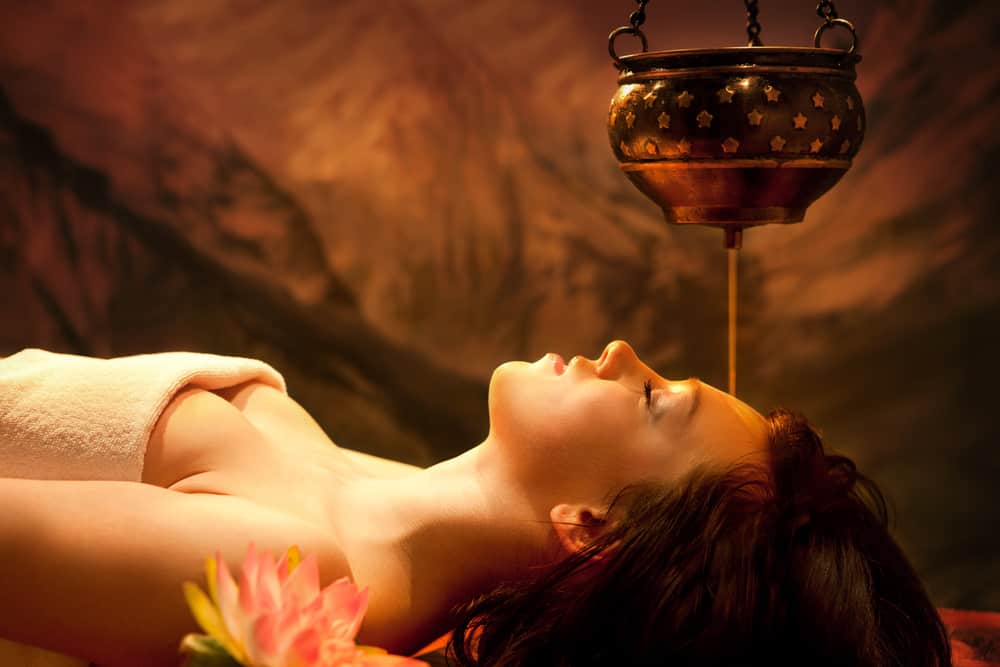Ayurveda is an ancient Indian approach to medicine that seeks to bring all body systems in balance with their environment. Logically, we know that when our life and health feel out of balance, we feel stressed, tired, and “off.” So naturally, ayurvedic practices are an excellent solution for stress relief.
Even if you aren’t familiar with ayurvedic practices, you can easily incorporate them into your daily approach to wellness. Here’s how to apply the ancient wisdom behind ayurvedic rituals to your daily life.

What is Ayurvedic Medicine?
The term Ayurveda comes from Sanskrit. It translates to “the science of life.” The practice of Ayurveda originated in India approximately 5000 years ago. About 60% of the global population still uses Ayurveda and other alternative medicines, and ayurvedic practices are particularly popular in India and Nepal.
The concept of Ayurvedic medicine was derived from the Vedas and other scriptural texts. The Ayurvedic philosophy looks at the body, mind, and spirit as a whole, aiming to achieve balance in all areas of the body and health for longevity and wellness. For example, yoga is interconnected and considered a “sister” to ayurvedic practice. Yoga deals more with the spiritual side, and Ayurveda addresses concerns with the body.
When combined, Ayurveda practices and yoga can bring a sense of balance and stress relief to the body. Like many alternative practices, there are scientific connections with western medical practices that can add credence to the Ayurvedic rituals and approaches to health.
We know that stress can cause us to feel run down and tired. When we’re stressed, our immune system is diminished, and we’re less able to fight off disease. Short-term stress can give us a temporary immune boost, but over the years, long-term stress can make us much more susceptible to illness and cause many adverse effects on our health.
Similarly, our diet plays a significant role in our wellness and immunity. When we eat healthily, we feel better and more aligned. Our digestion is better. In the short-term, we might reduce effects like heartburn and constipation. In the longer term, healthy eating can lower our risk of heart disease, diabetes, and some cancers.
Ayurvedic practices examine how we eat and balance stress from our environment and lifestyle. It looks at our personal constitution, emotional health, and balance of rest and activity. In Ayurvedic practices, our unique constitutions are referred to as our doshas.
There are three doshas: Pitta, Kapha, and Vata. Each dosha ties to an element. Pitta is linked to fire, Kapha is linked to the earth, and Vata is linked to the air. Pitta and Kapha are also tied to the water element.
Discovering Your Dosha
When people learn of doshas, most want to know, “what’s my dosha?” and “Will my dosha tell me what I should eat and how I can feel less stressed?”
Ayurvedic practitioners believe that eating and moving to align with your dosha is the best practice for health and wellness. You don’t need to be strict about it, but you can figure out your dosha and apply some principles to help you feel more aligned and boost your energy.
There are many dosha quizzes online you can find to help you determine your dosha (and many people fall into multiple categories), but here’s a rundown on the different dosha types, as well as diet and movement recommendations. You may notice that all the diets move towards whole, less-processed foods, which is generally a healthful practice.
Vata Dosha Type
In Ayurvedic practices, Vata doshas usually have a thin, lithe body type. Their hands and feet tend to get colder easily. Vatas are often energetic (in bursts) and good communicators. They are a creative type, but when they feel off-balance, Vatas get restless and distracted. They can have insomnia, anxiety, and dry skin.
Vatas often want quick, fast-paced exercises for movement, but to bring about a sense of balance, they should focus on grounding practices. Deep breathing, slow yin yoga, and connection with nature are all good practices for Vata-types.
For diet, Vatas should enjoy sweet fruits like figs, dates, mangos, apples, and bananas. Cooked vegetables are good for Vata-types, particularly root vegetables like carrots, sweet potatoes, onions, and turnips. Vatas can enjoy dairy and light meat in moderation (mainly fish and poultry). Nuts, seeds, and warming spices like cinnamon, ginger, and cumin are ideal for Vatas.
Vatas should avoid dried fruit and cold raw fruit (like watermelon). Frozen and raw vegetables can also throw Vatas out of balance, and Vata-types generally avoid heavier starches like corn and potatoes. Although most Vatas can tolerate dairy well, they may want to avoid yogurt, and dark game meats like lamb, venison, and rabbit don’t align with the Vata type.
Pitta Dosha Type
Pittas are the thinkers of the dosha types. They’re often hardworking and passionate about each endeavor. Pittas are athletic and muscular. They sleep heavily but in short bursts. Pittas tend to run warm, including in their emotions. They can have quick tempers and tend to be competitive. Pittas may get indigestion and can lean towards inflammation and skin rashes.
Movement is crucial for Pittas, and these natural athletes often have no problem with resistance training or taking on big challenges. However, it’s essential that they incorporate cooldown activities into their workouts as well. Gentle stretching and bending can help release some of the tension. Remember to slow down and breathe as you go.
The Pitta diet should include sweet and citrus fruits, including oranges and pineapples. For vegetables, seek those cruciferous veggies with a slight bitterness—cabbage, cauliflower, and broccoli. Leafy greens, barley, and quinoa are good for Pitta-types too. Poultry, shellfish, butter, soft cheeses, and milk are good protein sources, as are black and kidney beans, lentils, and chickpeas. Finally, include cooling mint and basil, as well as ginger, turmeric, and cinnamon, in the Pitta diet.
Pittas should avoid sour citruses like lemon and grapefruit. Nightshades like tomatoes, peppers, and eggplant can also cause digestive upsets. Pittas should consume less beef, duck, lamb, and pork and avoid sour creams and yogurts. They may not tolerate nuts such as cashews, peanuts, walnuts, and pecans. Pittas should also avoid corn and garlic. Cayenne pepper, paprika, and nutmeg can be tough on the sensitive stomach.
Kapha Dosha Type
Finally, we come to the reliable Kapha dosha type. These people are calm, nurturing, giving, and stable. They are generally consistent and sensitive to others. Kaphas are built solidly, with a thicker body frame. They are sound sleepers, but when this dosha type is off balance, they can lean towards weight gain, depression, and procrastination.
For movement, Kaphas should push themselves toward more vigorous activity to keep them feeling motivated. Kapha dosha types may benefit from the flow of Ashtanga yoga with constant movement and deep breathing.
As for diet, Kapha doshas usually enjoy all types of fruit—fresh and dried, as well as most vegetables. Oats, millet, barley, and corn are great, along with black beans, white beans, chickpeas, and lentils. Some Kaphas struggle with milk products and may do better with goat or soy milk. Freshwater fish, chicken, shrimp, and turkey are ideal protein sources. Sunflower and pumpkin seeds are great for Kaphas, and they tolerate and enjoy many spices.
Kaphas should avoid certain citrus fruits like oranges, pineapple, kiwi, and grapefruit. Olives, squash, and sweet potatoes can go against the Kapha constitution, as well as rice and wheat. Kaphas may not tolerate cow cheese, milk, or yogurt, and dark meat is thought to slow down Kaphas and cause stagnation. Nuts are often not well-tolerated by the Kapha, and they should keep salt intake in check.
Quick Ayurvedic Practices for Stress Relief
A few ayurvedic practices and rituals can help bring a sense of balance to everyone, no matter their dosha type. Because Ayurveda is based on the idea that everything is connected, the goal is to help us all stay grounded, balanced, and in-tune with the world around us.
Many of the Ayurvedic practices and rituals are based on breathing and mindfulness. Western science has started to support the idea that rituals can be grounding, connecting, and stress relieving. Even without direct benefits, they can have a positive psychological effect.
Similarly, recent scientific studies have shown that paced breathing changes brain activity and helps reduce feelings of anxiety. By slowing down our breath, we may send a signal to our brain that changes the flight-or-fight response to anxiety and helps our nervous system relax. In addition, paced breathing makes us more connected and aware of our bodies and helps activate the region of the brain that keeps us aware of the present.
If you feel out of balance, you can try some of the following rituals into your daily routine to help bring your body and mind back to the present. They can be a great accompaniment during a detoxification diet or a shift to healthier eating and regular meditation practice.
1. Deep Alternate Nostril Breathing
Set aside between 1 and 10 minutes to do some deep, relaxed breathing. You can practice deep breathing anywhere and in almost any situation. If you want to really increase your relaxation, try including a calming essential oil like lavender in your breathing practice.
Some Ayurvedic practices do what’s called “alternate nostril breathing.” To carry this out, place a few drops of essential oil on your wrist and inhale the aroma deeply. Then put your index and middle finger between your eyebrows with your thumb and ring finger on either side of your nose. Use your thumb to close your left nostril while you inhale through the right side. Then use the ring finger to close your right nostril as you exhale through your left. Now alternate sides by inhaling through your left nostril, closing your right, and so on.
Sit in a quiet place with your eyes closed if possible as you do the alternate nostril breathing. Repeat the process for 1-10 minutes until you feel calm and relaxed.
2. Simple Hand Massage
The seemingly simple act of putting lotion on your hands can become a mindful Ayurvedic ritual when you do it deliberately and with intention. It’s amazing how these small moments of self-care can bring us back to our baseline and help refresh tired, sore, or tight hands and wrists after a day of working and using our phones.
To do this ayurvedic ritual, choose a lotion like Melaleuca’s Renew Intensive Skin Therapy or carrier oil with a few drops of your favorite essential oil mixed in. Peppermint can help refresh and give you a mood boost as well. Rub the lotion on your hands and move up your forearms. Use the thumb of one hand to rub and massage the base of the thumb on the opposite side. Hold and press your thumb firmly on any tense areas. Work your way up your inner forearm to your elbow. Extend your arm and wrist and flex. Then switch arms and repeat on the other side.
This ritual can be fantastic for musicians, artists, and anyone who works on a computer all day. It’s a great way to bring back circulation into your hands and promote better motor control!
3. Self-Care Foot Massage
The foot massage is very similar to the hand massage above. Although it may be a little more challenging to do this Ayurvedic practice outside of your home, it can be a very relaxing way to wind down in the evenings before bed. Lavender, peppermint, or eucalyptus are excellent essential oil choices for this practice.
Start with one foot and apply the lotion to your foot and calf. Rotate your ankle ten times to the left and ten times to the right. Then use your thumb and press into the arch of your foot. Work your way from the heel to your tow three times. Use a circular motion to work out any spots that feel tight or tender. Then massage each two. Work the outer part of your foot and then move to the sole using circular strokes. You can use your knuckles to work your heel and finish with gentle strokes moving from your toes to your ankles. Finally, pull each toe gently, then move to the opposite foot.
The relaxing Ayurvedic practice is excellent for runners and anyone who spends a lot of time on their feet. I find it incredibly soothing in the summer after wearing flat sandals or heels for a long day. It’s a wonderfully grounding ritual.
4. Neck Stretches
Nowadays, almost everyone experiences neck strain, headaches, or “text neck” from constantly hunching over our phones and desks. Of course, it’s always best to look for ways to make your workspace more ergonomic and neck-friendly, but if you catch yourself in a slump, this quick Ayurvedic ritual will significantly help.
Put a few drops of essential oil on your hands and rub them onto the back of your neck while standing. Inhale and lift your chin towards the sky, then exhale and bring your chin to your chest (as comfortably as possible). Inhale, and bring your chin to the center. Exhale and look to the side. Inhale, back to center, and tilt your ear to your shoulder. Exhale, back to center, and repeat on the other side.
5. Soak Your Body
Bathing and soaking are prevalent Ayurvedic practices because they connect our bodies to water and help us relax. A twenty- or thirty-minute bath is one of the best ways to calm down and restore balance at the end of the day. You’ll lower your stress levels and reconnect with your body. Use Epsom salts and your favorite essential oils to enhance the experience.
Once in the tub, lean back and fold a cool washcloth—place it over your eyes and face. Breathe deeply and slowly. It can be helpful to focus on something you are grateful for, a happy memory, or someone you love and care for. Feel the positive feelings in your body and how they radiate from the center of your body’s heart chakra. Focus on cultivating feelings of balance, gratitude, and love.
Ayurvedic practices are a healthy way to bring more mindfulness and wellness into your life. Focus on the ways of eating, meditating, and bringing balance to your life. If you’d like to learn more about this ancient wellness practice, I highly recommend The Ayurveda Bible: The Definitive Guide to Ayurvedic Healing. This book is used by many Reiki practitioners and Yogis alike, and it contains excellent information presented simplistically and has beautiful pictures to go along with it as you read. Highly recommend!
Learn more about wellness:








Comments & Reviews
Thanks for these 5 little tips. I have already used them to some extent, practicing while I read. I want some Tangerine oil. I did them with the lavender oil I have on hand. Such small things can make you feel amazing.
sure wish my dog could do the applying for me, so I could just enjoy!
Hey Trialynn!
You are certainly welcome! Tangerine oil is one of my favorites as well, although there are many great scents out there. It is amazing how the small things make a big difference, especially over time.
Ha! Your dog may not be able to apply, but they, too, can appreciate with their wonderfully adapted noses.
Good seeing you on here!